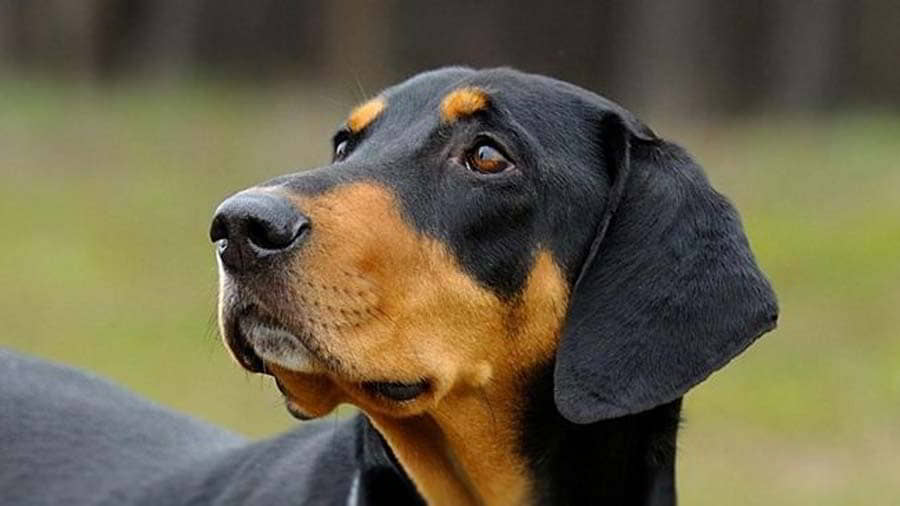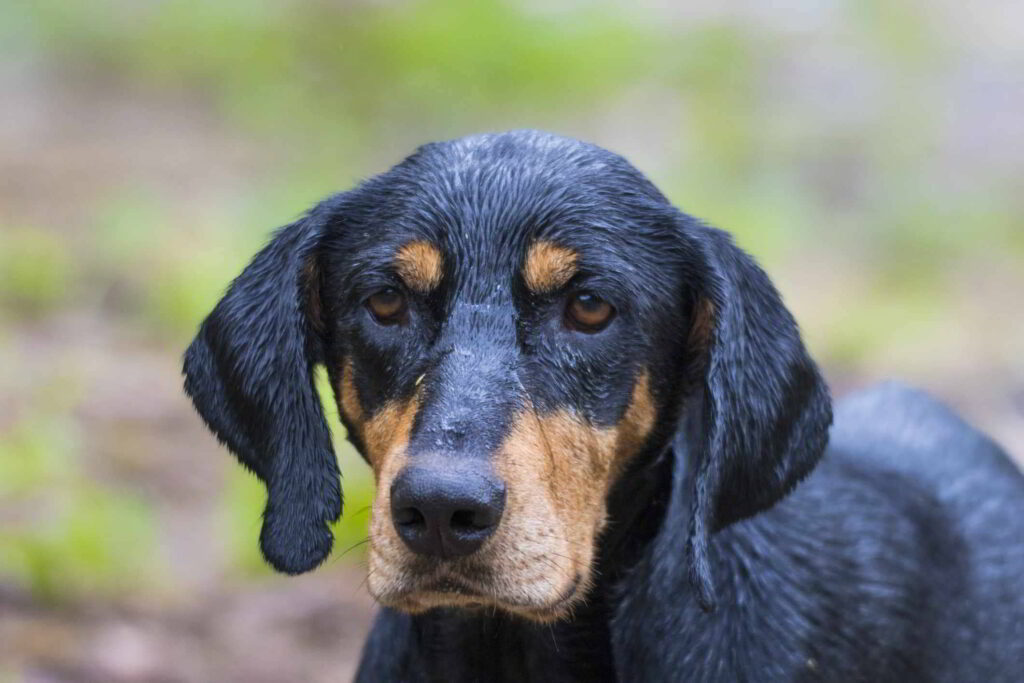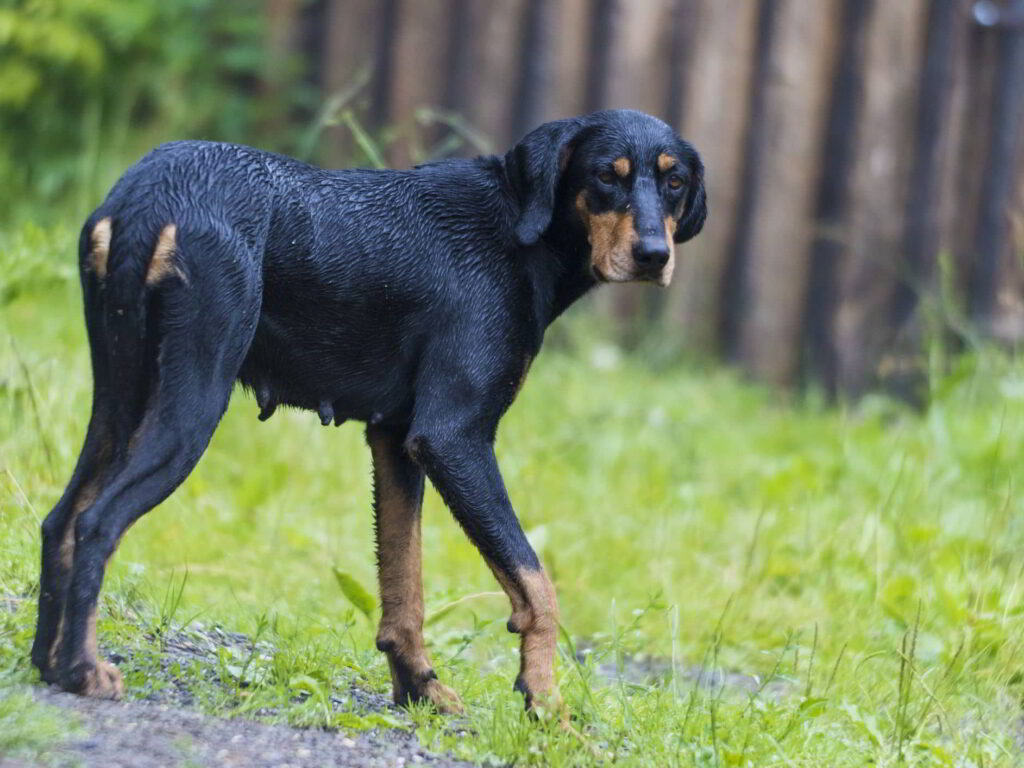Characteristics, History, Care Tips, and Helpful Information for Pet Owners
The Transylvanian Hound is a medium-sized black-and-tan hunting dog that originated in Transylvania, which was formally part of Hungary (today, it is part of Romania). The Transylvanian Hound, which is known as the Erdelyi Kopó in its native country, is extremely rare, both in its homeland and in the United States.
The Transylvanian Hound is classified as a scenthound, which means it uses its excellent sense of smell to track and trail large game like bear, bison, deer, lynx and wild boar, as well as small game like fox and rabbits. The breed continues to hunt wild boar to this day in Transylvania. Though they have the instinct to track and chase, Transylvanian Hounds never kill anything. Known as driving hounds, Transylvanian Hounds point and flush game (scare it from its hiding place), then drive it toward the hunter with high-pitched, ringing barks and other vocalizations. Transylvanian Hounds can also be taught to retrieve downed game.
Transylvanian Hounds are good-natured and quiet, yet also lively. Accustomed to hunting with other Transylvanian Hounds in small packs of two or three, most Transylvanian Hounds get along great with other dogs. They usually also live peacefully with other family pets, including cats when raised together. Although they are friendly, Transylvanian Hounds may be standoffish with strangers until they get to know them. With their own people, Transylvanian Hounds are loving and affectionate, and are great playmates for the family children. They bond very closely with their very owners.

| Breed Overview GROUP: Scenthound (UKC) WEIGHT: At Least 55 Pounds HEIGHT: About 22 To 26 Inches Tall At The Shoulder COAT: Short, Straight, Dense, Flat Double Coat COLOR: Black With Tan Markings LIFE EXPECTANCY: 10 To 14 Years |
Characteristics of the Transylvanian Hound
| Affection Level | High |
| Friendliness | Medium |
| Kid-Friendly | High |
| Pet-Friendly | High |
| Exercise Needs | High |
| Playfulness | Medium |
| Energy Level | High |
| Trainability | High |
| Intelligence | High |
| Tendency To Bark | Medium |
| Amount Of Shedding | Low |
History of the Transylvanian Hound
A popular hunting dog for Hungarian aristocrats during the Middle Ages, this ancient breed is thought to date as far back as 500 AD. The Transylvanian Hound is possibly related to a more common Hungarian hunting dog, the Viszla. Over the years, the Transylvanian Hound’s numbers dwindled and, by the turn of the 20th century, the breed was in danger of becoming lost forever. A group of breed fanciers brought the Transylvanian Hound back from the brink of extinction in the late 1960s. Originally there were two varieties: long-legged and short-legged. Only the long-legged Transylvanian Hound remains. Today, the breed’s numbers remain low, though dedicated breeders continue to work to preserve this ancient treasure.
In 2015, the Transylvanian Hound was recorded in the American Kennel Club (AKC) Foundation Stock Service (FSS), a step toward eventual full recognition. The breed will be assigned to the Hound Group when it achieves full recognition with the AKC. In 2006, the breed was fully acknowledged by the United Kennel Club. Internationally, the breed is recognized by the Fédération Cynologique Internationale (FCI).

Transylvanian Hound Care
The Transylvanian Hound has an easy-care short double coat that sheds very little. Check inside your Transylvanian Hound’s ears every week, and clean them with a pet safe ear cleaner if they look dirty. Brush the coat a few times a week with a soft bristle brush and bathe when dirty. Trim the nails every other week (less often if the dog wears them down naturally when running around outside). The black-and-tan coat has a shiny appearance and is somewhat coarse to the touch. If you see sign of redness, inflammation, or foul odor coming from the ears, schedule a visit with your veterinarian.
Transylvanian Hounds are highly intelligent and less stubborn than some other hound breeds. They learn quickly when you use positive, reward-based training techniques and the right motivation (extra tasty treats work best). Keep training sessions short and always end on a high note when your dog gets something right. Transylvanian Hounds can be wary of strangers, but lots of early socialization during puppyhood can keep this from becoming a problem. Transylvanian Hounds are highly active and energetic, with plenty of stamina-they are reported to cover as many as 100 miles when out hunting. If you provide ample daily exercise and mental stimulation, a Transylvanian Hound will be mellow and relax for the remainder of the day. They enjoy unstructured activity like walking, hiking, jogging, and swimming, as well as instruction for competitive dog sports like agility, tracking, or obedience.
Common Health Problems
While the Transylvanian Hound is generally healthy and hardy, hip and elbow dysplasia is sometimes seen in the breed. Responsible breeders perform health screenings on their adult dogs before breeding them to ensure they do not pass on any hereditary issues to their puppies.
Diet and Nutrition
Most Transylvanian Hounds are energetic and athletic dogs. Very active Transylvanian Hounds may do well on a high-quality, calorie-dense diet, but less-active dogs may require diets with fewer calories to avoid weight gain. Excess weight can worsen joint disorders like hip and elbow dysplasia, and may lead to other health conditions like diabetes. If you don’t know what diet is best or how much feed your Transylvanian Hound, consult with your breeder or veterinarian. Always feed measured meals twice a day rather than free feeding (leaving food out all day).
Pros
- Good family dogs
- Friendly and adventurous
- Good with dogs and other pets
Cons
- Very rare and hard to find
- Requires lots of exercise
- Standoffish with strangers

Where to Adopt or Buy a Transylvanian Hound
If you have your heart set on a Transylvanian Hound puppy, you might have to wait a while. There are few Transylvanian Hound breeders in the United States. Rarely, an adult Transylvanian Hound might find its way into rescue. The Transylvanian Hound Club includes a website and Facebook page where breed lovers can connect.
More Dog Breeds and Further Research
If you like the Transylvanian Hound, you might also like these breeds:
- Black and Tan Coonhound
- Vizsla
- Wirehaired Vizsla
Otherwise, check out all of our other dog breed articles to help you find the perfect dog for you and your family.


0 Comments